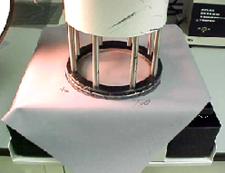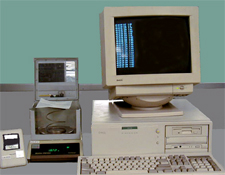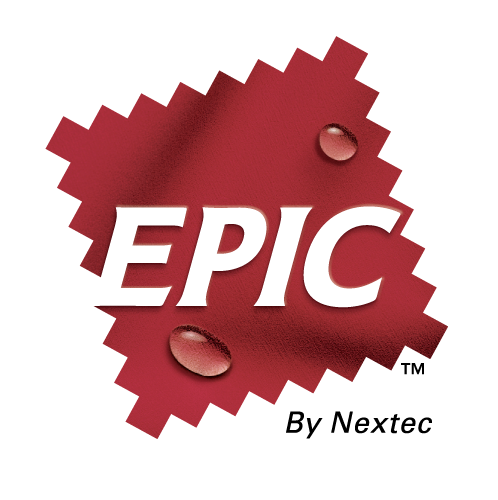TECHNOLOGY
EPIC by Nextec® fabric. It's water resistant, windproof, breathable and washable. But how? Our patented Nextec® encapsulation process is what makes it possible. The protection is inside the fabric, encapsulating the actual fibers for weatherproof performance. No laminates. No coatings.How It Works
Testing

MVTR
Overview: MVTR is a measurement of the amount of moisture vapor that can pass through a fabric under very controlled conditions.
Procedure: There are many different methods to determine MVTR, most involve small cups of water covered with a sample of fabric and placed inside a climate-controlled chamber. After 24 hours the cups are weighed and the moisture vapor transfer rate is calculated (units g/m2/day.)Â
Relevance: The very nature of the standardized conditions required to perform the MVTR tests limit their usefulness. Without incorporating temperature or pressure gradients, the test cannot account for real world variables. Claims of high breathability numbers in the lab are not necessarily representative of field results.

SUTER
Overview: The benchmark waterproofness test, it measures the amount of pressure it takes to pass water through a fabric.
Procedure: Water is steadily pressed against fabric until the water penetrates the fabric.
Relevance: The concentrated water pressure created in the Suter test is an extreme exaggeration of that encountered in real world conditions, therefore the test is not an accurate gauge of performance in the field. The Suter test also disregards how greatly breathability is sacrificed in pursuit of extreme water repellency.

BUNDESMANN
 Overview: Comprehensive measurement of performance properties.
Procedure: Fabric samples are secured over the top of metal cups. Crossbars rotate behind the fabric simulating body movement inside a garment. Water falls from a height of five feet onto fabric samples. A visual scale measures how well water beads up and rolls off the fabric (repellency.) The fabric is weighed before and after the test to determine how much water it has absorbed. The volume of water in the cup is measured to determine how much water, if any, has passed through the fabric.Â
Relevance: With the severity and duration of this test, the Bundesmann creates a performance profile that relates closely to how the fabric will perform in the real world.

DRY TIME
Overview: Measures drying time of a fabric which has been made wet under standardized conditions.Â
Procedure: A fabric specimen is placed in distilled water and allowed to come to equilibrium, then placed on a balance at specified temperature and humidity. The balance is interfaced with a computer and the change in weight is recorded every second. Weight loss is equal to the amount of water lost to evaporation. The time the fabric takes to reach consistent weight is considered dry time for the material.Â
Relevance: Drying time is an important element of fabric performance. A garment that remains wet and cold will draw heat from the body. The faster a garment dries, the less likely the wearer is to experience heat loss and discomfort.
Glossary
Water Resistance
A measurement of the pressure at which water passes through a fabric.
Water Repellency
The degree to which a fabric resists the penetration of water at a set pressure.
Wet-Out
The effect seen when a fabric begins to absorb water. Wet-out will compromise the breathability of a fabric. Laminated and coated fabrics rely on a DWR (Durable Water Repellent) for water repellency but the DWR will not prevent a fabric from absorbing water once they have worn off.
Windproof
A fabric’s ability to stop air passage at a certain pressure.
Packability
A measure of a garment’s ability to compress into a small space. Coated and laminated fabrics have additional layers that add weight and stiffness. Encapsulated fabrics pack more easily in very small spaces because they don’t have extra layers.
Breathability
The ability of a fabric to allow moisture vapor to be transported to the outside.
Laminate Technology
A technology by which a film is bonded onto one side of a fabric, compromising breathability and hand. The technology may delaminate and often has a stiff, boardy feel.
Coating Technology
A finishing process whereby a coating is applied to one or both sides of a fabric and results in an increase in water resistance but a decrease in many other tactile properties. These include breathability, suppleness, drape and performance at extremely cold temperatures.
Encapsulation Technology
A process patented worldwide by Nextec Applications, Inc. that places an ultra thin polymer around the fibers and precisely places a tough, breathable barrier inside the fabric and between the fiber bundles. This process is engineered to maximize performance attributes such as breathability, water resistance, durability and packability without negatively impacting tactile properties.
AATCC
American Association of Textile Chemists and Colorists
ASTM
American Society for Testing and Materials
ISO
International Organization for Standardization
DWR (Durable Water Repellent)
A water-repellency treatment applied to fabric by immersion in a chemical bath. Fabric treated with a DWR will cause light rain to bead up and roll off, though heavy rain will eventually cause the fabric to wet-out. And, after some time, water will penetrate the fabric. DWR finishes are not durable and wash out or wear off.
Frequently Asked Questions
What makes EPIC by Nextec® fabrics different from all other performance fabrics?
Other performance fabrics rely on laminates, coatings or Durable Water Repellent (DWR) treatments to provide protection. The Nextec® encapsulation process places the protection inside the fabric.
How is fabric encapsulated?
Our patented Nextec® encapsulation process places an ultra thin polymer around the individual woven fabric fibers.
Why is encapsulation the best fabric protection for most outdoor activities?
Encapsulation provides the all-weather protection you need, without sacrificing breathability, comfort or packability. Tiny “micro holes” between the encapsulated fibers allow water vapor to escape, without allowing outside water and wind to penetrate.
Why are laminates inferior to encapsulation?
Laminating a waterproof membrane to fabric provides impervious resistance to water, but sacrifices breathability, comfort and hand.
Why is a DWR treatment inferior to encapsulation?
DWR treatments are applied to fabric either through spraying or by immersing in a chemical bath. The DWR treatment provides a moderate degree of water repellency, but isn’t windproof. It can easily be overwhelmed by heavy rain and can wear off or wash out of a fabric over time.
Are EPIC by Nextec® fabrics waterproof?
EPIC by Nextec® fabrics are highly water resistant. This means they resist penetration by water under all but the most extreme conditions.
Are encapsulated fabrics durable?
The encapsulation process can actually add strength to base fabrics, improving test results for abrasion resistance and tear strength.
Is the encapsulation process permanent?
With proper care and regular washing EPIC by Nextec® fabrics will perform for the life of the product.
What types of fabric can the Nextec® process encapsulate?
Polyester, nylon, cotton and stretch woven fabrics. Our encapsulation process can be used to produce more types of performance fabric than any other treatment.
Who else produces encapsulated fabrics?
No one. Our encapsulation process is patented worldwide from start to finish.ings.
What is a soft shell?
A soft shell is a garment made with highly water-resistant, breathable, lightweight fabric. With our encapsulation process, we offer the ultimate all-weather soft shell performance.
When should I wear a soft shell garment?
Golfing, hiking, climbing, cross-country skiing, anytime you need comfortable, lightweight and breathable protection that can take you from sunshine to showers to snow flurries and back.
What is a hard shell?
A hard shell is a garment made with fabrics and features that offer impervious protection from sustained downpours. The fabric is laminated or coated and often features taped seams.
When should I wear a hard shell garment?
When you’re in a hurricane, monsoon or other sustained deluge.
Why should I buy a water resistant jacket made with EPIC by Nextec® fabric for nearly the same price as a waterproof, seam-sealed jacket?
While a hard shell, waterproof, seam-sealed jacket is designed to perform during an extreme downpour, it’s compromised breathability makes it a less than ideal choice under more typical conditions. A jacket made with EPIC by Nextec® fabric provides versatile comfort and protection in all but the most severe conditions, making it a more useful, functional garment.
